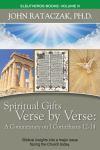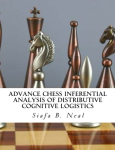K.E. Garvey's Blog, page 6
December 24, 2015
Rogue Lawyer… by John Grisham
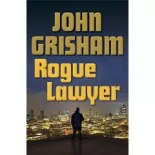 There isn’t much I can say about the writing, style, voice, characters, or plot. When I pick up a Grisham book, I expect him to deliver. And in Rogue Lawyer he delivers on cue.
There isn’t much I can say about the writing, style, voice, characters, or plot. When I pick up a Grisham book, I expect him to deliver. And in Rogue Lawyer he delivers on cue.
The only thing I wasn’t crazy about was the ending. It wasn’t bad, as some books are, but it wasn’t as neat as I would have liked. There were a few loose threads that weren’t essential to the read, but important enough for me to realize immediately that they were left hanging. Sebastian and Naomi, Sebasian and Starcher (hated that name, btw). Again, not a dealbreaker, but I would have liked even a paragraph on each.
One thing I couldn’t get out of my head for the entire read (not necessarily a bad thing)… Anyone who has ever watched A Time To Kill or The Lincoln Lawyer might agree… Throughout the entire novel, I heard each passage narrated by the protagonist, Sebastian, in the voice of Matthew McConaughey. Crazy as it sounds, Jake Briggance has left an indelible impression on me! I think it’s because Sebastian Rudd has the same basic personality and attitude. (Who doesn’t like Matthew McConaughey… and aside from Dallas Buyer’s Club, his lawyer roles are my favorite.)
Definitely a book worth reading and I think most Grisham fans will enjoy his new approach.
Kathy Reinhart is the award-winning author of Lily White Lies and The Red Strokes among others under the name Nova Scott.
Website – Facebook – Fan Page – Twitter – LinkedIn –Instagram – Goodreads – Amazon


December 10, 2015
The Munich Girl… by Phyllis Edgerly Ring
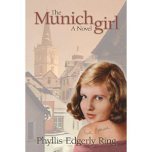
The Munich Girl
Synopsis:
Anna Dahlberg grew up eating dinner under her father’s war-trophy portrait of Eva Braun. Fifty years after the war, she discovers what he never did—that her mother and Hitler’s mistress were friends. The secret surfaces with a mysterious monogrammed handkerchief, and a man, Hannes Ritter, whose Third Reich family history is entwined with Anna’s. Plunged into the world of the “ordinary” Munich girl who was her mother’s confidante—and a tyrant’s lover—Anna finds her every belief about right and wrong challenged. With Hannes’s help, she retraces the path of two women who met as teenagers, shared a friendship that spanned the years that Eva Braun was Hitler’s mistress, yet never knew that the men they loved had opposing ambitions. Eva’s story reveals that she never joined the Nazi party, had Jewish friends, and was credited at the Nuremberg Trials with saving 35,000 Allied lives. As Anna’s journey leads back through the treacherous years in wartime Germany, it uncovers long-buried secrets and unknown reaches of her heart to reveal the enduring power of love in the legacies that always outlast war.
Review:
The Munich Girl is a work of historical fiction that reads and feels like a memoir. So many of the story’s details are historically accurate that it is hard to determine where the facts leave off and the fiction begins.
Beautifully told, and exquisitely written, each page unfolds like the wrapping over a gem. The settings are vivid, the characters come to life. It is a rather involved story between Anna’s existence with a narcissistic husband, the budding relationship between her and Hannes, her mother’s story that neatly intertwines with Eva’s. There are also the premonition-like dreams and the chapters written in her mother’s hand to keep you turning pages.
Told in a focused and experienced style, every page draws you further into the story. Hard to put down, even harder to forget.
Kathy Reinhart


November 27, 2015
The Secret of Magic… by Deborah Johnson
I truly have been busy between the move and doctor appointments and have fallen behind with my reviews and interviews alike, but I’m hoping to get back on track soon. Last night, while many were collectively relaxing following their Thanksgiving dinner, I finished reading The Secret of Magic, by Deborah Johnson.
Synopsis:
Opening the mail for her mentor and employer, Thurgood Marshall, at the NAACP office in New York, Regina Robichard is captivated by a letter from famous southern author M. P. Calhoun, asking for an investigation of the murder of a young black man, Joe Howard Wilson. Robichard is a fan of Calhoun, having read her book about a magical forest and an unsolved murder. As a stand-in for Marshall, Robichard travels to Revere, Mississippi, to find out the truth behind the murder of Wilson, who was among scores of black men returning from the war, unwilling to put up with the humiliations of racism. What she discovers are parallels between life in Revere and Calhoun’s book. How much of the book is real, and how does it connect to the murder? Inspired by her grandfather, who fought in WWII and was a huge admirer of Thurgood Marshall, and her own admiration of Marshall colleague Constance Baker Motley, Johnson (The Air between Us, 2008) offers a completely engaging southern gothic with unforgettable characters in this fictionalized account of a pivotal NAACP case from the 1940s.
Review:
The Secret of Magic is a book within a book. Although my initial thoughts were that such a stylistic choice would be hard to follow or confusing, my initial impression was wrong.
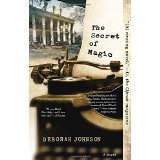
The Secret of Magic
First, the pros:
The author’s voice and style. Much of her prose is poetic. The flow and delivery of the story is smooth and melodic.
The setting. The author sets up 1946 rural Mississippi well enough to take us there without an overload of detail to take away from the story.
I enjoyed the fact that the read and the book within ran parallel, not too much of the book within the book to become daunting. Johnson flawlessly shared the pages of her novel between a whimsical land and the harsh realities of 1940’s rural south.
Characters. My favorite part of the book was its characters. They depict the true south, the way it was during that period. It was a time when white and blacks alike knew their place, and obeyed the unwritten rules on the surface, but held each other in regard on the inside. Racial issues have always been a source of contention and the author successfully portrays the issues of that period.
Now, the cons:
Everything seemed to tie up too neatly. The guilty parties admit to their crimes almost without provocation. Granted, during that period they never dreamed they’d have to pay for what they’d done, but for a white man to tell a black, female attorney from New York just for the sake of telling her – not very believable. Another example, Peach knows to give the jail key to Regina and Regina just happens to need it. I also thought it was a bit predictable, but still enjoyable.
The Secret of Magic was definitely worth the investment of time and the pros far outweighed the cons. If for no other reason, read it for the author’s style and the characters. They won’t disappoint.
Kathy Reinhart is the author of the award-winning Lily White Lies, The Red Strokes, and Missouri in a Suitcase.


October 13, 2015
Linda Westphal
IDI – Good morning, Linda. I’ve had a few unexpected issues lately, which put me behind with interviews, but I’m glad to finally be able to talk with you. Let’s start with something a little broad. Define a great book.
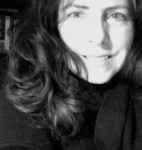
Linda Westphal
LW – When I must have the paper version of a book in my personal library, I know it’s a great book. In some way the book has touched or inspired me deeply, or I feel connected to the story or a character. It’s in my library because I want easy access to the book.
A great book may also be a book that you did not like when you were, say, 22 years old, but at age 32 or 42, you pick it up again and not only are you able to read it straight through, you love it. I think of this when I start reading a book that’s not resonating with me at the moment I’m reading it (every page feels like work). Reading is a very personal experience. Who you are — your interests, what’s going on in your life at the moment you pick up a book — all play a part in how you feel about a book when you are reading it. If this happens to you, put down the book and pick it up again in a few years; you may have a different reaction to the story.
IDI – They say know the rules and then you may break them. Which rules do you find yourself breaking and how does it work in your writing?
LW – When I made a decision to write fiction, I read everything I could get my hands on about the art of writing a story. How to develop characters. How to write dialogue. How to develop a plot. What makes a good writer great. None of these how-to guides helped me, because all I could think about during the writing process was Am I following the rules? To write a great story, you have to forget all the rules and just write. Write every day. Visit the story every day, even if it’s only to write one sentence. Keep at it until you reach the end. Then edit like crazy.
IDI – Great answer! When was your Eureka moment? When did you know you were born to be a writer?
LW – While I have been writing on and off most of my life, my Eureka moment happened just a few years ago. It came to me while I was reading. I never planned to be a writer, but here I am. Now I can’t imagine being anything but a writer. Funny how it all works out, and how we are naturally pushed into what we are meant to be doing.
IDI – Tell us about the picture on the cover of your book The Medium. Was it taken in Savannah, Georgia?
LW – Indeed! It’s a photo I took in 2003 when I spent about three weeks in Savannah’s Historic District. It was my first visit to Savannah and I was mesmerized by the city. During my stay I purposely did not rent a car, because I wanted to get to know the Historic District. I’ve traveled a lot so I know it’s nearly impossible to get to know a place while you are in a car. You have to walk, at a slow pace, to really see a city. I wanted to get to know Savannah’s history, the charm of its 22 squares, the architecture and iron works, the hidden gardens, and walk the cobblestone streets. I can tell you without a bit of hesitation that Savannah vibrates with energy (both past and present) and is a joy to visit.
Surprisingly, no one has asked me about the white orb in the middle of the photograph. There’s an interesting story about it. I
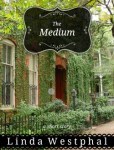
The Medium
was out for a walk with my Olympus digital camera with ultra zoom (the fabulous iPhone camera had not yet been invented), when I saw the building you see on the book’s cover. I had to photograph it. I took a few shots, then started to walk away when I had an urge to turn around and look at the building one last time. I took two more photos, then felt satisfied I had what I needed. Later, when I was reviewing the day’s photos, I noticed the orb. It was the first of the two photos I had taken after I turned to take another look at the building. The two shots were of the same angle and taken a second or two apart; the first photo had the orb, the second one did not. If you have never researched orbs in photos, I highly recommend it. The information is fascinating. I know the orb in my photo is the energy of someone who once lived in Savannah. Whoever it is, he or she wanted to be in the photo. I wonder if this person knew that the photo would some day be on the cover of a popular book.
IDI – Wow. That is interesting. Savannah is my top three favorite cities in the country. There’s so much history there. Linda, every author has his/her own style, but what writer would you say your style most resembles?
LW – I hope my writing style resembles writers whose writing voice I admire, such as Michael Crichton, John Caples, Elizabeth Strout, Fannie Flagg, John Grisham, E. B. White, and many other writers. I strive to write in a simple, clear manner, which is what I hope I have in common with these writers.
IDI – You just mentioned some of my favorite writers! How much time/effort do you put into social media as a means of self-promotion?
LW – It’s important for authors to be near their readers. If readers spend time on a website, blog, or social media channel, that’s where the author should go. I think every author should be on at least one social media channel. I’m on Goodreads, Twitter, Facebook, Google+, Tumblr, and I have an active website and Amazon Author Page. I try to visit these channels at least five days a week and spend a minimum of 15 minutes a day on them (combined, not each channel).
IDI – I need to take a page out of your book. I wish I could limit it to 15 minutes a day, but with that little time, I never seem to be able to reach the end of the email, replies, RTs, comments, et cetera. Is there a particular area of your writing (getting ideas, revision, editing…) where you seem to struggle the most and how do you overcome it?
LW – Developing ideas is easy for me, editing is too. The challenge (I think this is a challenge for most people) is taking an idea or theme and shaping it into an interesting story. Another challenge for me is the overall size of the task of writing a novel (I’m used to writing 1,000-5,000 word pieces). If I think about all the things that go into a novel — characters, themes, place, plot(s), ending — I get overwhelmed. To overcome this, I break it down into smaller tasks. First I develop the story’s theme. Then I develop the characters and where the story will take place. The rest comes during the writing and editing process.
IDI – The book, The Hermit Bookstore, has a theme running through it. What does the theme mean to you and why did you choose to write about it?
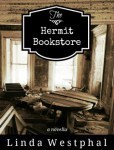
The Hermit Bookstore
LW – One of the themes in The Hermit Bookstore is, even if you are not aware of it, there are moments when you are receiving hints, a nudge, or support from the other side. This help is coming from people you love who have passed on to the other side, or your spirit guide, or an angel.
I decided to include this theme in the story because of the tiny moments of help I’ve noticed in my own life over the years. At first, it’s easy to dismiss these moments. But when you pay attention, you begin to see bits of “magic” that happens precisely when you need it to happen. It could be a person you meet when you need to meet them; a comment that’s said when you need to hear it; a nudge to look up at the car in front of you at the right moment; a feeling to take a different route home from work; the alarm clock that fails, causing you to miss the bus that’s involved in an accident. There are endless possibilities. You just have to pay attention. And see that they are too important to be mere coincidences. Try it yourself for a few months; I think you’ll be surprised what you see.
IDI – We all draw from within and I believe there is an element of ‘us’ in everything we write. How much of you will a reader find in any given book?
LW – I agree. There’s a piece of the writer in everything he or she writes. It can’t be helped. Sometimes I don’t see myself in my stories, but people who are close to me tell me they recognize a part of me in them.
IDI – One last question. When you find yourself in a rut, where do you turn for inspiration?
LW – I look for story and character ideas in everything I do — books I read, movies and TV programs I watch, people I talk to, eavesdropping in public. Being observant is a very important characteristic of a writer. You can do this by being present in the moment as much as possible during the day. Many of the experiences you observe will become part of your story during the writing process.
IDI – Linda, this was wonderful. Thank you so much for joining me today. Best wishes and continued success to you!
Linda Westphal writes feel-good stories, like The Hermit Bookstore and The Medium.
Her stories include characters who explore life events that cannot be explained but are true based on firsthand experience, such as coincidence, help from people who have passed on, interactions with angels, intuition, and mind-body-spirit topics.
Linda lives in northern California with her family and enjoys travel, tea, food, sunny days, friendly people, and reading a good story.
The Hermit Bookstore is a 2015 TISBA Finalist in the Fiction Category.
Visit http://www.LindaWestphal.com to sign up to receive Linda’s blog posts, news, giveaways and updates.
Join Me!
Website – Facebook – Fan Page – Twitter – LinkedIn – Instagram – Goodreads – Amazon – Wattpad
Books!
Lily White Lies – The Red Strokes – Missouri in a Suitcase
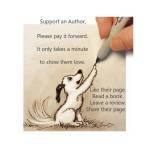
Support An Author


October 7, 2015
John Rataczak
Today I take a step away from the fiction authors I usually interview to speak with a Christian writer with many titles under his belt. Help me to welcome John Rataczak.
IDI – Good morning, John. Thank you for joining me today.
JR – Thank you for having me.
IDI – John, what works for you? Can you give us a rundown of your writing process?
JR – Before writing a book, I come up with an outline. For instance, The Ramifications of Our Salvation is in four sections and thirty-five chapters. The outline kept me on track throughout the process. Each chapter required considerable research. After gaining a good idea of what to write, I began to type. Considerable thought was given into word choice (diction) and how to develop an idea. Once a chapter was completed, I checked carefully for grammar, spelling. readability, and relevance. When the book was nearly ready for print, I checked carefully for accuracy in indentations, pagination, and consistency in listing Biblical references. In other words, I do my own editing.
IDI – What is the most important thing you have learned about writing? How has this helped you as a writer?
JR – Anyone who has written a dissertation knows that it is the most challenging project one undertakes in his/her education. Anyone who writes non-fiction books also learns that they can be just as challenging to complete.
IDI – Is there a particular area of your writing (ideas, revisions, editing, et cetera) where you seem to struggle the most and what do you do to overcome it?
JR – When I began writing, I knew very little about word processing and editing. In addition, I had no idea about where to go for book covers, websites, a publisher, so many things! I found that the answers came through considerable prayer and just as considerable hard work.
IDI – Tell us, what does an ordinary day in the life of John Rataczak entail?
JR – I don’t know if I have many “ordinary” days. An ordinary week involves ministry at a Gospel mission, Bible studies at nursing homes and a public library, visits with people in hospitals, counseling, and considerable work on Eleutheros Books.
IDI – What do you think of Amazon and the reviewing process they use? How much trust do you put into a review for any given book?
JR – Every author I have come into contact with has an unfavorable view of Amazon. To put it simply, it is good to the customer but unfair to the author. I do not shop on there; so I cannot give an honest opinion of how valuable anyone’s review of a book might be.
IDI – I agree with your assessment of it being good to the reader and unfair to the author. I recently worked with an author who told me she had several reviews removed due to her personal connection with the reviewers. She said the six reviews they removed were from people she had never spoken with, but Amazon left the reviews from acquaintances intact. Go figure.
We all like to read positive reviews. What is your reaction to a negative review? Be honest.
JR – I have received a number of positive reviews concerning my books and appreciate the kind words. Negative reviews? Actually, I haven’t received any that were actually written. On occasion a reader disagrees with my theological perspectives and says so, but I allow them to say what they have to say and move ahead with what I am convinced is the truth.
IDI – One last question, John. Do you have a blog and what type of questions would a reader find on it?
JR – I do have a blog. John’s Blog
IDI – Thank you so much for appearing with me and I wish you continued success in your writing endeavors.
John Rataczak was born in Columbia, Missouri, and raised in the St. Louis area. He was saved at an early age through the ministry of the Chatham Bible Church. His father was a chemical engineer and his mother was a housewife. Both were saved during John’s early childhood years. God led John to become involved in full-time Christian work during his freshman year at Bob Jones University. Since that calling, he has earned a B.A. in the Bible, an M.A. in Pastoral Studies, and Ph.D. in New Testament Text (Greek). He has taught in three Christian colleges and two graduate schools, and his pastoral experience includes ministries in Pennsylvania and Ohio. Presently, he is the founder and sole proprietor of Eleutheros Books.
Join Me!
Website – Facebook – Fan Page – Twitter – LinkedIn – Instagram – Goodreads – Amazon – Wattpad
Books!
Lily White Lies – The Red Strokes – Missouri in a Suitcase


October 1, 2015
Siafa B. Neal
IDI – I haven’t played chess since I was a teenager (My mother forced me to since she loved it and couldn’t get anyone else to play. Once I began beating her, she stopped forcing me!) I remember the rules, but you take standard chess to a whole new level. I have to admit, I’m a bit impressed.
Why don’t we begin with you. Tell us a bit about yourself.
SN – Chess was taught to me by my Late father David Franklin Neal, Sr. Over the years chess became boring and I was searching for new styles of chess that were more interesting and complex in nature. As a result of my efforts, I founded and invented Advance 3-D Matrix Vector Logistics Chess which is an art form of chess played on several types of game board models. Each distinct model has its distinct rules and regulations of play. I am currently publishing several books on Model III, The Longitudinal Star Gate 14 Model. This space-aged model allows for the engagements of four (4) separate distinct chess game sets all at the same instant. In other words, the game board allows me to challenge four chess players instantaneously and spontaneously in a match; this means that I would have to CHECKMATE my opponents’ Kings at least the best of three out of four games to be declared the winner of the match. Each chess set has distinct color bands to distinguish one from the other. Through my books I am attempting to raise the awareness of chess to higher levels of cognitive dynamics. My books allow chess readers who crave for hours of game entertainment to have mind-boggling and mind-baffling fun.
IDI – Who or what inspired you to become a writer?
SN – My cousin, Robert H. Brown, who is currently a British citizen residing in England and who holds a doctoral degree in English was influential in my decision to pursue a writing career besides my Engineering interests.
IDI – Tell us about your books.
SN – My Advance 3-D Matrix Chess books contain Diagrams, Illustration, Drawings and Photos about the game board and the chess movements. Equations or Chess Statements are used to describe the movements of the chess pieces relative to one another. My chess books add excitement and pizzazz to what may seem to be a rather boring regular conventional chess game. My Advance 3-D Chess books presents the idea of practically playing chess from a 3-Dimensional perspective. My unique, one-of-a-kind chess books contain Diagrams about the game board, The Longitudinal Star Gate 14 Model, Model III, which makes relearning the games fun and easy to understand. It is imperative that readers understand the fundamental aspects of conventional chess to allow for the easy digestion of the new information which my chess books so vividly portrays. My chess books which comes in Print and e-Formats contains Equations or Chess Statements of each movement of the chess pieces relevant to the game(s). The equations display the symbolic mathematical Greek letters which describes the spatial relationships and relativity of the chess pieces on the game board of the Longitudinal Star Gate 14 Model, Model III.
Writing is a magnificent tool that enables me to promote ideas of Advance Chess to help enlighten others about the new styles and art forms of playing Advance 3-D Chess as opposed to the rather draconian ways of regular conventional chess and to offer some important moral compass for those readers who have an open mind to newer opportunities to explore and to exhaust the tapestry of psychological warfare under the philosophical guidance to exhaust the possibilities to newer, informative approaches to life in general. My rather unique chess books allows readers to Live for Greatness, the Greatness which comes from their minds and their hearts. It espouses the philosophy that, “You are what you think, you think, therefore, you are”. My books dare readers to explore and to rediscover their innate and yet dormant passion for excellence in their quintessential cognition quest along a journey that provides fun and entertainment in the process.
IDI – Where can your books be purchased?
SN – My chess books may be purchased at my author’s webpages which are:
www.coldcoffeepress.com/siafa-b-neal
www.coldcoffeecafe.com/profile/SiafaBNeal
www.amazon.com/author/siafabneal
www.independentauthornetwork.com/siafa-b-neal
IDI – What do you hope people will gain by reading your books?
SN – Readers who benefits from my books are:
– Those who may find that the classical game of conventional chess a bit boring.
– Those chess readers who are eager to learn the new, exciting concepts of Advance 3-D Matrix Chess.
– Those chess readers who are chess enthusiasts and have high expectations of the game.
– Those readers who have an open mind and are receptive to newer challenges and complexities of Advance chess games.
– Those readers who seek finger-nail-biting, seat-gripping excitement towards the new exciting games of 3-D chess.
– Those chess readers who crave for hours of entertainment with non-conventional, out-of-the-box strategic games that are mind-boggling, mind-baffling and mind-blowing.
– Readers who are avid Chess players who may fall in the spectral range ranks of Beginners, Intermediate, Semi-Professionals and Professionals.
– Readers who play chess as a hobby and who take joy in experiencing for the first time the learning experience about the complexities and challenges of the intense psychological warfare of Matrix Chess.
– Readers who crave for the ULTIMATE battle plan war games.
– Chess readers who desperately want to divulge into the pseudo-dynamics and quasi-kinetics World of Chess in order to explore and to exhaust the opportunities to test the plasticity boundary limit ranges of their full spectrum cognitive elasticity cognition capabilities and potentialities.
– Those chess readers who may want a different perspective to their intelligence test for Logistic and Strategic Diagnostic and Prognostic Analysis.
– Chess readers who want to acquire the new, exciting gaming knowledge about Advance 3-D Chess and to progress ahead of the learning curve well above the Master and Grand-Masters of the classical games of conventional chess.
– Chess readers who crave for the ULTIMATE Collector’s book items in chess gaming.
IDI – This is what some have said to be a controversial question. What are your thoughts on Amazon and the reviewing process they use? How much trust do you put into reviews on any given book?
SN – Amazon is a huge venue to advertise your book or any items for that matter. Millions of books are being advertised on amazon. The reviewing process that they use seems to be somewhat standard and fair. The reviewing process gives a kaleidoscopic perspective about an author’s book with insightful information about an advertised book which provides a potential book buyer the necessary tools to make intelligent decisions about whether to make a choice of purchasing a book or the contrary.
IDI – We all like to receive positive reviews. How do you react to a negative review? Be honest.
SN – Negative reviews are the most welcomed perspectives for assessing my writing progress. I use the constructive negative reviews to make the necessary improvements to my writing style and to assess how others view my work. The negative reviews helps to indicate the areas in my book that need improvements so that the book may be critique and morph into a master piece that I the author could be proud to republish if necessary.
IDI – Think back to the first book you wrote. Now think back to the last book you wrote. In what ways have you grown?
SN – My writing style have shown improvement and maturity. The photographic techniques used to take the photos of the games has also improved. Most notably the playing levels of sophistication of my chess games have also shown tremendous improvements. I try to make my games last longer with complicated strategic movements and provide logic explanations for the reasoning behind a significant chess movement such as the capture of a piece and the CHECKMATING of the opponents’ kings.
IDI – How long does it generally take you to write a book from the spark of an idea to the finished product?
SN – The time frame for the general completion of my book is about two months. I first start with the sketch of the model used for the games. Next I purchase the materials for the model and design the model. Thereafter, I color code the chess pieces and play the games using hybrid variations of positional configuration possibilities. While playing the games I record the movements and take photos of the games which I use in my manuscript for my book. I proof read the book and sent the final draft to my publisher.
IDI – Favorite author and why?
SN – My favorite author is Charles Dickens who wrote the Tale of Two Cities. His book was used as a study sample during my high school education. His style of writing a more traditional and has an eloquent style of communicating with words that captivates his reader’s attention.
IDI – When you find yourself in a rut, where do you turn for inspiration?
SN – I consult my mother, Anna B. Neal for general advice and a different perspective on how to resolve the issues that confronts me. My chess games are delicate and sophisticated that I would take months for an average reader to comprehend the meaning behind the movements of the chess pieces in the Advance 3-D Matrix Chess games.
IDI – How much time/effort do you give to social media as a means of self-promotion?
SN – About 95% of my project time is spent on the social media promoting my books. Advertising is essential to raise the awareness of the public of the publication of my Advance Chess books.
IDI – What advice would you give to new/unpublished authors?
SN – The publishing business is a competitive market which many authors both well-known, because the readership love their style or genre of writing and unknown because the author may be new to the industry. It is important that your work in your genre stands out and is exemplary from the crowd of published authors. A new author may want to use the following questions when critiquing or honing their writing skills:
A. What makes my work unique?
B. Why would a reader want to read my novel?
C. Am I allowing my published work to speak for itself without being so pretentious?
D. What would compel a reader to purchase my book?
E. Do I emulate a passion for writing my book?
F. Am I consistent with my daily rigorous efforts to process and apply my writing skills to my unpublished work?
G. Do I have what it takes, the love, the passion, the zeal, the time, the resources and the effort to become a successful writer with the awareness that the book publishing industry is a competitive market which implies that the financial rewards may not necessarily be immediate or forth-coming spontaneously?
H. Am I constantly actively writing my next book despite the fact of accomplishing the current book?
I. Do I apply the right networking skills and exposure for my books?
J. How do I relax while writing the manuscripts for my current book or my next near future books?
K. Do I have the right organizational skills to write my next book in an orderly sequence and format?
L. How do I augment my Reading, Writing and Speaking skills to meet the growing demands of the book publishing market?
IDI – Siafa, in conclusion, I’d like to share one of your YouTube videos with my readers:
IDI – It truly has been a pleasure and I certainly learned things I never knew about the game. Thank you so much for appearing with me and best wishes for success.
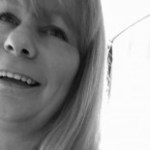
Join Me!
Website – Facebook – Fan Page – Twitter – LinkedIn – Instagram – Goodreads – Amazon – Wattpad
Kathy Reinhart is the author of the newly released ‘THE RED STROKES’, the award-winning ‘LILY WHITE LIES’, and her debut novel, ‘MISSOURI IN A SUITCASE’, (the latter written under the pen name, Nova Scott).
Before venturing into the world of mainstream fiction, Kathy wrote articles of interest for online enthusiast magazines, most notably on the subjects of horses and eventing.
A firm believer in paying it forward, she created and maintains the popular, INK DROP INTERVIEWS, where she features one-on-one question and answer sessions with Indie authors, spotlighting their work and thoughts on the subjects of writing and the publishing industry.
Kathy is currently working on book one in the ‘LIKE A GIRL’ series, with ‘CRY LIKE A GIRL’, due out early 2016.
Aside from the time she can spend with friends and family, a few of Kathy’s other interests include horses, cooking, traveling, antiquing, kayaking, paddle-boarding, and home decorating.


September 24, 2015
Eric Mondschein
IDI – Eric, I can’t tell you how happy I am to have you join me here today. For those who may have missed the review, Life at 12 College Road is a book of vignettes, stories from your childhood. Not only was it well-written, but your stories reminded me of my own childhood, an era gone by. I also want to mention that your book is still holding a 4.9 rating on Amazon. Impressive.
Eric, when did you know you were meant to be a writer?

Life at 12 College Road
EM – That is an intriguing question and one I have thought about. Unfortunately, I don’t think I have ever experienced a “Eureka moment” about writing or anything else for that matter. But I do know it was in my first year as a college student at Wesley College in Professor William A. Hughes creative writing and English Literature classes that I found that I was interested in writing. He urged me to write. At the time it was poetry, but that is where the seed was planted. But at the time I chose a different path and it would be many years before I returned to writing as he had warned me would happen. He is gone now, but I am sure he knows I finally took his advice.
I also want to say that no one makes me write. In the professional positions I’ve held over the years, I have been required to file reports, write memoranda, even treatises, but I was never required to publish law-related articles, write poetry, or, of course, author Life at 12 College Road. But I certainly did not write because I had nothing better to do. The time spent away from family and the activities that were sacrificed along the way attest to that. It was more often a feeling of being compelled to write. Not for others, although most writers do want people to read their work, but to feed a need or a desire coming from within. I’ve felt particularly driven to write about my experiences growing up. The writing is not really so much about me as it is about those feelings and emotions—joy, happiness, sadness, anger, fear, even loss—that each of us, in our own way, inevitably encounter.
Through this writing experience, I have also come to recognize that even in the solitude of writing, we are not really alone. Our memories of loved ones; friends, and those we admire are always with us. Some are nearer to the surface of sentience than others, but they are there nonetheless.
And if we are really willing to listen, they have much to offer.
That might of have been more than you wanted to know by your question, but that is where it led me.
IDI – I want what’s in you to say. For the record, I’d prefer a long, comprehensible answer than one-line that tells the reader nothing.
How did you come up with the idea for Life at 12 College Road?
EM – That is a good question because I actually had not intended to write this book at all. I was on a mission to write an action/adventure thriller and was attending a writer’s retreat in Maine several years ago to do just that. But I wasn’t getting anywhere with it, so I decided to take a short nap. As fate would have it, the idea for Life at 12 College Road came to me while I was dreaming, or perhaps during that period of time just before awakening.
I recalled sitting at the dining room table where I had shared Sunday dinners with my family growing up. As I sat at the table, I realized the other three chairs had been tilted forward so that their ladder-backs rested against it. They were obviously no longer of use. And it was then that I remembered what had been bothering me: I was alone. You see, my mom, dad, and younger brother have all passed on without me. They are exploring new worlds and I have been left behind. Heck, even my dog is gone.
It was that realization, those memories, which provided the impetus for me to put my novel on the shelf and write Life at 12 College Road. The book is a collection of thirty-three “real life” short stories that, when taken as a whole, paint a mosaic of a time and place both familiar and distant. Although they fit together, each piece of the mosaic can be viewed and enjoyed on its own, and each provides a different glimpse into the world of growing up in 1950s and 1960s America.
In time, I may get back to the novel, as every once in while I think I hear the characters trying to talk to me.
IDI – What are you working on now? Can we get a peek?
EM – I would like to tell you that after I finished writing Life at 12 College Road I picked up where I had left off with the thriller. But that is not the case. I am now co-authoring a monograph and teaching supplement that is being published by the Education Law Association (ELA) with a colleague and friend, Ellery (Rick) Miller Jr., on the subject of sexual harassment and bullying. It’s called Sexual Harassment and Bullying: Similar, but not the Same, and will be available in November of this year. The monograph explores the current legal developments in the areas of sexual harassment and bullying K-12. It also examines strategies for developing and implementing policies and training to create an educational environment that allows each student to feel safe and secure, and to ensure a safe school environment conducive to learning. The Teaching Supplement is designed to provide the instructor with activities that will enhance students’ understanding of sexual harassment and bullying as they explore the legal issues involved, examine the concerns related to developing strategies and crafting and implementing policy to confront them. We both thought the issues of bullying and sexual harassment were too important to ignore and we wanted to provide not only teachers and administrators with information and activities to confront them, but also the entire community. If people are interested the books will be available in November from the: Education Law Association Bookstore.
——-
(It is not your “regular or traditional Excerpt, but if interested here is an excerpt from Sexual Harassment and Bullying: Similar, but not the Same)
We all remember those school experiences when we were bullied. Often they are etched on our memories, a permanent scar of humiliation, of being defeated, of being embarrassed. Often we were told to get over it, ignore it, and turn the other cheek. We were told, “boys will be boys,” or “that’s just the way girls are.” It was part of the school experience, but in the great majority of incidents the results were not life-threatening and the physical injuries usually minor. Conversely, we might look back and consider with some chagrin and regret when we were the bully, picking on someone with less power, less popularity, or less status in the group. Incidents of bullying occurred, but in most schools they were the exception rather than the rule.
Today, bullying is occurring much more often and, with our new technologies, students are being bullied at school, on the bus, and in their homes. V-mail, e-mail, Twitter, and Facebook have become weapons used to humiliate and bully. Recently, bullying has received major attention in the national media as horrific stories of the results of ongoing bullying have surfaced. Sadly, some of these incidents have resulted in the deaths of young people. School systems are scrambling to develop appropriate policies and procedures. A number of states have passed bullying laws that either criminalize bullying incidents or provide prescriptions for school system enforcement.
As the focus on bullying has grown, attention to incidents of and concern about sexual harassment has diminished. It is easy to understand that sexual harassment can be a form of bullying, especially when it is used to intimidate, but it is also a form of discrimination prohibited by federal and state laws. It is not a new phenomenon, but its unacceptability is now ingrained in our laws and practices. Both girls and boys can be victims and/or predators. Since the 1980s, schools have been required to address issues of sexual harassment of students. Yet, after over twenty years, nearly half of seventh through twelfth-grade students in an American Association of University Women’s (AAUW) national study complained of being sexually harassed in 2010. The study indicated that students used rumors, gossip, groping, and/or physical assault to harass other students based on sex or their gender. Just under one-third of students self-identified as engaging in harassing behavior.
——-
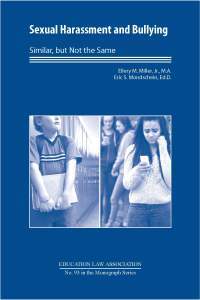
Sexual Harassment and Bullying
Of course, when I am finished with this project I will have a discussion with the characters in my novel to see if it’s time to take them down from the shelf.
IDI – That sounds like something we can’t stress enough in our current times as it seems to be a growing issue within our schools.
Do you have a blog and if so, what type of posts would a visitor find on it?
EM – Yes I do have a blog and it can be found at: http://www.ericmondschein.com. There you will find my musings on current events, commentaries on issues of import, poetry, the outdoors, and even some of my recipes. I have even included several of the short stories from my book. But if readers really want to know more about me they should read Life at 12 College Road.
IDI – Do you have a favorite author and what is it that really strikes you about their work?
EM – That is not an easy question to answer, but as you have put me on the spot, I would have to say Dean Koontz. He has a way with character development that makes them so human and alive. In many cases the main character is someone I would really enjoy meeting. Odd Thomas is one such character I would thoroughly enjoy hanging out with if it were possible. He is also is a phenomenal storyteller and his plots and dialogue bring every page to life. I find in many cases once I pick up a book of his I just can’t put it down until I have finished it. And I would be remiss if I did not state that he also knows how to scare the heck out of his readers.
IDI – I’ve asked this same question in the past and this is not the first time his name has been mentioned. I am almost embarrassed to say that with the many books I read, I don’t believe I have ever read one of his. I’ll have to change that!
How much time/effort do you put into social media as a means of self-promotion?
EM – Now that is a question I have been grappling with for a while now. Not just how much time and effort, but wondering often if it is worth it? Today we are working in a world of author-driven marketing. The days of sitting back and doing a book signing here and there are a thing of the past, if in fact that is all it ever really was. These days I find myself beginning each day checking my mail and then going to Facebook, Twitter, BingBing, Google+, Pinterest, and LinkedIn making sure to post not only about my book, but also making sure I am heard from, sharing poems sharing writing tips, commenting on events if the day, but keeping my work and my name in the public domain. So I spend over an hour or more each day, seven days a week, reading and posting in the world of social media. Have I sold books through social media? The answer would be yes, but more importantly I do know it has increased the number of visits to my website and that has helped sales as well. It is something today’s author just has to do.
IDI – We all know marketing lies (mostly) with the author. Aside from social media, what forms of marketing have you engaged in? Book fairs, signings, podcasts, et cetera… Have you found them beneficial?
EM – Besides the social media marketing efforts I have also participated in book fairs, book signings and readings at local bookstores, and I have spoken at book clubs, and at senior citizen writing group meetings. I must confess I have enjoyed these events very much and but for one, sold books at each event. I especially enjoy book readings where I can share my stories with people and it is also fun to mingle and get to know folks interested in not just my stories, but books in general during the social portion of these activities. I also believe it is important to support our independent bookstores as so many are closing around the country, and these bookstores and public libraries are more important to the life and health of local communities than they realize.
IDI – Every author has their own style/voice (if we’re doing our jobs right), but what author would you say your work most resembles?
EM – You do ask some tough questions. I have listened a lot to stories by Garrison Keillor and have always enjoyed his writing. And I was quite humbled when a review of my book was posted on Amazon.com suggesting that if you liked Garrison Keillor you would like my book. So I guess I would have to say my writing in a small way may resemble that of Garrison Keillor. Perhaps it’s more so because of the subject matter of the stories rather than the writing. My style however may be similar as I do try to write as if I am sitting in front a few close friends, and telling them a story. So I guess my writing style is one of storytelling. I want the reader to feel that I am talking to them and sharing something of value to me.
IDI – What is the best advice ever given to you, and by whom?
EM – As it relates to writing, the best advice was given to me by Professor Hughes, who I mentioned earlier, and that was to “read, read, read and then read some more.” Conversely, the advice I chose to ignore was that I probably should not try to write, and there is no need to mention who gave me that advice.
IDI – Even in an interview, you leave your reader wanting more! That’s okay, we don’t need to know who it was, just that they were wrong. :)
Do you have anything specific you would like to say to your readers?
EM – Without giving anything away, I would think that after reading the book one might come away wondering just how I could have survived. But as I wrote the book, and am now answering your questions, I am happy to report I survived. The book is about growing up in suburban/rural New York in the 1950s and 1960s. The main character, as a young boy and teenager, is confronted with many of the issues and concerns of that time. I think, however, that many of the concerns, questions, problems, and conflicts I encountered will be familiar to just about anyone, at any age.
The tools and knowledge at our disposal may differ, but as human beings we all generally go through the same stages of growing up and discovering what is really important. In reflecting on my past, I found that it was not the earth-shattering events that were most significant to me. Rather, it was the small things; many long forgotten until recently, that deeply and indelibly touched me. Sure, some of the memories involve fire trucks, police cars, and hospital visits. But most do not. And if their retelling can help the reader to connect with similar moments from their own life, well, that to me is special.
IDI – Eric, I would like to thank you for appearing here with me today. After reading your memoir and speaking with you today, I almost feel as though I know you. I’m a fan for life! Best of luck with your upcoming endeavors.
EM – It’s been my pleasure, Kathy
——-
Life at 12 College Road
Life at 12 College Road is a collection of thirty-three “real life” short stories that, when taken as a whole, paint a mosaic of a time and place both familiar and distant. Although they fit together, each piece of the mosaic can be viewed and enjoyed on its own, and each provides a different glimpse into the world of growing up in 1950s and 60s America. The book differs significantly from most traditional memoirs in both content and form. Rather than relate the most newsworthy moments of his life in a linear, chronological narrative, Mondschein focuses instead on more intimate memories from his childhood life in rural New York in a series of colorful vignettes.
It’s not always the earth-shattering events that are most significant in our hectic lives. More often, it’s the small things, many long forgotten, that touches and shapes us most deeply. Our memories of these events might bring smiles, or anger, or even a desire to forget, but every one of them helps to make us who we are today—and in some ways, who we will become tomorrow. Join Eric Mondschein at the unhurried pace of a cup of coffee for a surprising and powerful journey in which laughter inevitably mingles with tears, sorrow turns to joy, and loss almost becomes bearable.
————————-
Dr. Eric “Rick” Mondschein is an author and education consultant. He has taught law and education at the undergraduate and graduate levels of education. Having worked for the U.S. government in several capacities, he has published and edited numerous articles and books in various areas of law and education, and has written and managed numerous grants from the private and public sectors. Rick has also consulted on policy development and implementation, and conducted training for administrators, teachers, and school staff. He directed an award-winning, law-related education program for the New York State Bar Association from 1980 through 1994. In 1993, he was the recipient of the American Bar Association’s Isidore Starr Award for exemplary achievement in law-related education.

Eric Mondschein
From 1995 to 2006, Rick advised the governing board of an international, non-governmental organization in Haifa, Israel, in the area of external affairs, including government relations and security. He provided analysis of human rights situations in select countries throughout the world in general, and in Iran and the Middle East in particular. He also served as the citizen representative of The Post Star editorial board, which won the 2009 Pulitzer Prize for editorial writing.
Rick is the author of Life at 12 College Road, published by Something or Other Publishing, which is a collection of short stories about growing up in America in the 1950s and 1960s.
He currently resides in the Adirondack Mountains of upstate New York with his wife, Ginny.
Join Me!
Website – Facebook – Fan Page – Twitter – LinkedIn – Instagram – Goodreads – Amazon – Wattpad
September 23, 2015
Running In Heels… by Mary A. Perez
More than a memoir—this book is a promise of hope for anyone who was abandoned as a child, to anyone who woke up hungry and went to bed hungrier every day, for every wife who has loved a husband who left bruises on her heart and on her body.
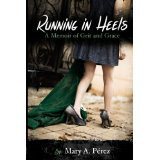
Running In Heels
Somewhere between stealing cold cuts from stray cats and watching a stranger leave her mother’s bed after breaking in through their bedroom window, Mary figured out that her family was dirt poor. Worse than her empty stomach, she was hungry for acceptance and love. She thought she found it when her baby sister was born and she became her “mommy”, taking care of her needs as best she could at the age of seven. Then she had to say goodbye over a small white casket.
Mary’s grandparents, first generation immigrants from Puerto Rico, took her in and gave her a glimpse of faith and stability. For a brief, shining spell, she had a real home—until they decided that Mama needed her. They may have been right, but Mama needed more than a little girl could give and Mary lost her way again.
Just out of Juvy Hall, Mary found a knight in shining armor to take her away. She became a teenage bride to a man twice her age—a man as deeply enslaved to booze as every “step-dad” she’d had as a child. She loved him anyway, even wearing the bruises he gave her, even when she tried to leave him to give their children a better life. Despite her fear and loneliness, she never imagined it would take a gunshot in the middle of the night to teach her courage. She was even more surprised when rediscovered faith paved the path to forgiveness after so many years of pain.
Running in Heels is a memoir of the grit and grace that carried a young girl through the shadows of her mother’s choices and on through an abusive marriage. Mary A. Pérez narrates an incredible story of survival in the face of hopelessness, and learning to forgive against all odds.
A story of coming of age, and coming into grace.
Review:
I was recently asked to review a memoir by a woman I do not know personally. I had actually never heard of her before that initial contact and accepted a copy of her book in exchange for an honest review. Although I once turned away all requests for reviews – only reviewing books of my choosing – I have slowly begun to accept requests. I have come across a few good indie reads and a few not so good. Her book sounded interesting, so I agreed.
Running In Heels is not good because the reader will learn all the juicy tidbits they’ve come to expect from a celebrity autobiography. It’s not good because her story is unique or made national headlines and is in any way familiar to us. It’s good because (but for the grace of God) it could have been anyone’s story. It’s relateable. It’s emotional. It’s raw. And today, it’s something that happens far too often.
Mary takes us on a journey that begins with her early childhood and ends with present day, hitting all of the life-changing elements without adding the unnecessary tidbits that would bore a reader. In a candid delivery she shares what it’s like to grow up without food. What it’s like to grow up too fast. What it’s like to love and dislike a person at the same time. We feel her loss, we share her pain, and we root for her to rise above.
Told in first person, Mary recounts many of the most emotional, painful stories of her life. She calls out others (including family members) on their part in her pain, but she also shares her own faults and mistakes. She credits those who made her life sane.
Mary shows us how to love someone who is less-than-worthy, how to look past a person’s flaws to find their heart, and how to forgive those who have caused the most pain. She teaches us that even though you may be a damaged soul, there is life and light if you allow God to lead the way.
This is not a religious book, per say, although Mary’s faith is evident once she decides to follow. She shares many heart-breaking stories, but I think it was her happy-ending that stirred the most emotion in me.
There were a few slow spots, but there wasn’t one that took away from the read. Before I reached the point where I wanted to start skimming, the pace picked up and the story continued to move along at a steady tick.
I know that most recommendations for ‘great reads’ go to well-known authors while indie authors are challenged with getting their books into readers’ hands. I hope that if even in a small way, I can help Mary to do that. This was truly an enjoyable, well-told story and one I think many people would relate to. Highly recommended.
Join Me!
Website – Facebook – Fan Page – Twitter – LinkedIn – Instagram – Goodreads – Amazon – Wattpad
Books!
Lily White Lies – The Red Strokes – Missouri in a Suitcase


September 21, 2015
Margaret Mal
IDI – Good morning Margaret, thank you for joining me today.
Tell us a little about the books you’ve written.
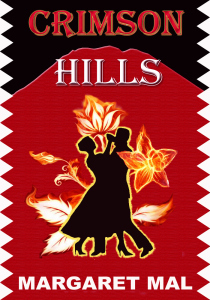
Crimson Hills
MM – I’ve written 13 novels. The newest one, Crimson Hills, is in English; the others are in Russian. I’ve published 7 detective novels in Russia. But Crimson Hills is not a mystery. It’s an adventure dystopia about a few people who are so obsessive about their fate and future that they decide to make a really dangerous journey, which can give them all the necessary answers. I’ve self-published this novel through Kindle.
IDI – When did you realize you were born to be a writer?
MM – When I was 16, I wrote my first detective novel (this novel, by the way, 11 years later was published by the biggest Russian publishing house). Before that, I’d had several attempts to write a book, but none of them had ended. So when I finished that book, I told myself “Wow, I can do it!” That’s when I totally knew. However, some acquaintances of my family told them I was going to be a writer even earlier, when I was a little child, because of my ability to rhyme. I created my first poem when I was 5 or 6 years old. I couldn’t write then; thus, my granny wrote it down.
IDI – I hope she hung on to them!
Think back to the first book you wrote and then think to the last one you wrote. In what ways have you grown as a writer?
MM – At the age of 16, I was less wise, less smart, less tolerant and less experienced than I am at the moment. And these are the things you need to use while writing a novel. So I guess now I can write a little bit more qualitative books.
IDI – How long does it usually take you to write a book from the initial spark of an idea to the finished product?
MM – Between the spark and the start of the writing process there can be a really long time; it varies. I can tell that it takes me roughly 2 months to write the whole book, from the first word to the last one, if the idea is totally thought-out. However, this time frame only works for me when I have nothing else to do. Unfortunately, you can’t just write books and enjoy your life; very few people can do that. The most of authors are paid so badly for their writing that they have to work somewhere else. And when you have a full-time job, you can’t give enough attention to your books. That’s why the most of my books took a year to write each.
IDI – Give us a rundown of your writing process.
MM – What works for me, first of all, is silence; second of all, is music. Hard to unite those two, huh? :) Well, silence is above all. When you write a scene, you have to merge yourself into this atmosphere. It’s hard, and every extraneous noises make it even harder. As to music, I use it when I can’t put myself in the right mood. For example, when I have to write a scary scene, I open my playlist and listen to some creepy music, like soundtracks from horror movies, etc.
IDI – You’ve said that due to the low earnings, like yourself most writers have to work outside jobs. What do you do for a living?
MM – I tried many jobs. I was a social worker, an accountant, a manager, a journalist, etc. Now I’m trying myself as a screenwriter. I’ve made a few episodes for a Russian TV-show Trace (something similar to American C.S.I.).
IDI – Who is your favorite author, and why?
MM – Being Russian, I’ll pick Mikhail Lermontov. I adore his poetry, and I adore his novel A Hero of Our Time. It’s deep, it has so many levels, you can reread it twelve times and never get bored. He was a great writer with such a horrible fate. As regards non-Russian writers, I choose Oscar Wilde and John Fowles. I love the way they drew their characters.
IDI – We all draw from within. How much of ‘Margaret’ will a reader find in one of your books?
MM – Much, very much. As to Crimson Hills, there are some characters (may I conceal which ones?) whose all thoughts, fears, and moral values were taken from myself. But the whole story and characters’ biographies are, certainly, just a fiction.
IDI – What is the hardest or most frustrating aspect of writing: ideas, getting started, writer’s block, editing?
MM – The last one. As English is my second language, it’s really hard for me to edit my books. I can check every sentence carefully and be still not sure if everything is fine and understandable.
IDI – I can see where that would be an issue.
What do you do when you’re not writing?
MM – I love to travel. I’ve been to France (twice), Spain, Germany, Czech Republic, Belgium, Poland, Belarus. My dream is to see the whole world! Beside traveling, I like to study and to learn. I already have two degrees (Economics and Journalism), and I’m not sure if I’m ready to stop, lol. Also, I’m into self-education. I enjoy learning something new.

Margaret Mal
IDI – Is there something you can’t live without?
MM – Chocolate! Muffins! Pies! Green tea! These are the most important things in life! (Kidding. Well… Ok, not kidding, it’s all true.)
IDI – Define a great book.
MM – There are books dedicated to entertainment. There are books that make readers think; it is clever books for intellectual process. Both are good. Well, I think that a great book is the one which contains both funny stuff and intellectual stuff. It’s certainly the most difficult to write. That’s why it is worth readers’ attention the most. In Crimson Hills I tried to combine action and philosophic, romance and religion, laugh and social drama. I don’t know if I achieved this goal; it’s up to my readers.
IDI – In the end, it’s always up to the readers. It was a pleasure talking with you Margaret and I wish you the best of luck with your writing. Hopefully, we’ll be seeing future books released in English as well.
About the author – Margaret Mal was born in Russia. Her Russian pen name is Margarita Malinina. Crimson Hills is her first book in English (dystopia). You can find it HERE. You can find Margaret on Instagram or Facebook.
Join Me!
Website – Facebook – Fan Page – Twitter – LinkedIn – Instagram – Goodreads – Amazon – Wattpad
Books!
Lily White Lies – The Red Strokes – Missouri in a Suitcase


September 16, 2015
Artifice: Nights of Shadow, Book 1… by Lianne Miller
Synopsis:

Artifice, Nights of Shadow: Book 1
Eliza Ross believes she is living an isolated life in Montana without family or friends. Then a mysterious stalker turns her world upside down. The cops think she is crazy, but the medical doctors soon discover that Eliza isn’t normal—and they are determined to find out why.
Dmitri Markov is a Druzhina who knows everything about Eliza, but his mission is to make her forget. He will do whatever it takes to keep her alive and deliver her to Shashenka Belyakov. Other elite Druzhinas are sent to assist Dmitri in recovering her from the hospital. They will not fail.
An unlikely friendship with a mortal enemy only deepens the mystery, putting Eliza on a collision course with Dmitri and immersing her in a shadow realm where nothing is what it seems. As the truth unravels, Eliza learns that she must destroy the one responsible for enslaving her, or she’ll never be free—but as she races into the unknown, she unwittingly sends Dmitri into a downward spiral that may doom them both.
Review:
Belonging to the supernatural/fantasy genre, it is in complete contrast to the southern fiction and mysteries I generally read.
It did take me a little while to get into the vampire mindset, but after the initial odd feel, it began to flow.
Artifice comes in at just under 500 pages. Since I am unfamiliar with the genre, I was also unfamiliar with its typical word count, but it seemed long.
At first.
Now that I have finished it, I can tell you that the length fit the story. Too many books these days contain filler, or fluff, to take a book to a predetermined word count. This was not one of them. The story held its tension and conflict throughout and its flow was steady.
As far as characters go, there was a definite difference between genres. In women’s fiction, mysteries, YA, romances, et cetera, when I care about a character, it’s usually on an emotional level. In this book, I cared about the main characters, but on more of a situational level. I rooted for a positive outcome to their situation, but I can’t say I felt a real emotional attachment to any one character.
Being that Druzhina’s are vampires, there will obviously be differences between them and humans. I felt the author did a remarkable job illustrating those differences (while maintaining the human element). From the small details like their ability to heal, nocturnal living, to the fierce loyalty to one another, she painted the picture without drilling it in. She gave her readers credit for getting it on the first mention.
The Druzhina’s dialogue felt stilted, somewhat formal at times. In a romance, general fiction, or a legal thriller, it would have read like poorly written dialogue, but in this story, this genre, it added to the realism of the characters. They are an army of sorts and playful, snappy, witty dialogue like you’d find in a Jonathan Tropper novel would not have worked here.
The author manages to include various settings from around the world. Giving a perfect balance of description without relying too heavily on it, it did not take away from the story. This is an area where I tend to skim-read or skip completely when an author drones on about everything from the setting sun to the long shadows to the traffic and so on. The author set up her scene and then allowed the characters to move the story along, never breaking pace.
Artifice is the first book of a series. There are two types of series. In the first, each book stands alone. You can read one or all, in any order and enjoy them the same. In the second type of series, to truly enjoy the story as a whole, you have to read them in order, beginning with book one. Artifice left so many unanswered questions regarding the main story-line that I finished it feeling a bit cheated. Granted, that is not a flaw in the writing or the author, but rather, the intention. If you read book one and enjoy it, the chances of returning for book two are much greater. I, for one, would prefer to have major plot points resolved with only lingering questions to entice me to read book two, otherwise, it feels like an incomplete read. In a sense, it’s like being held hostage. If the first book is received well, most will return for the next without leaving everything up in the air in book one. But, that is merely my preference and not a flaw in the writing. I’m sure there are many who enjoy the anticipation in waiting for the next installment.
I found most of the chapters to be short and concise. Again, this is a personal preference, but I liked the general chapter length. It made it an easy read. Many times I was going to put the book down to take care of something around the house and ended up reading much further into it than I intended because short chapters make ‘just one more chapter’ irresistible. I had told Lianne I would begin reading it the following week after receiving it. I picked it up the night I received it just to browse and ended up finishing it the following afternoon.
Artifice is a promising debut and one with the ability to entice those who have never ventured into the supernatural genre. It’s not the bats-hanging-from-rafters, coffin-sleeping, garlic, crucifixes and steel stakes type stuff of decades gone by. The story is more human related than vampire related. I would recommend it and keep in mind that by the time you read it and like it, book two will be out.
Join Me!
Website – Facebook – Fan Page – Twitter – LinkedIn – Instagram – Goodreads – Amazon – Wattpad
Books!
Lily White Lies – The Red Strokes – Missouri in a Suitcase




